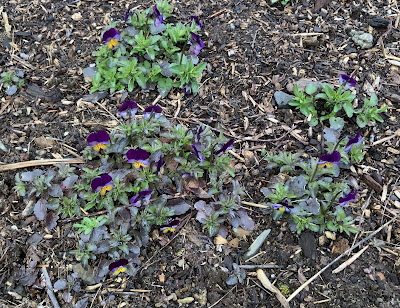A bunch of interesting tips and suggestions emerged once again at my “Grow a Homestead-Style Food Garden” class this week. I always get lots of really helpful takeaways from our discussions—and figured some of you might benefit from the collective wisdom of the class!
Native Plants and Pollinators
One topic we discussed at length is pollinator-friendly plantings,
especially natives.
I know I talk a lot about plants for pollinators, but hey, bees and all kinds of pollinating insects are crucial for a productive food garden!
One experienced gardening student, who raises an epic tomato
crop, expressed concern about his orchard: the apple tree blossoms were starting to
open but...he wasn’t seeing any bees in his garden!
I realized I’d noticed the same thing!
It’s been a cold spring in our county, and even the early
blooming/pollinator-drawing plants haven’t fully bloomed yet. I’ve got a few
open daffodils going, but so far, I’ve seen exactly one bumblebee in my yard.
No other bees of any kind.
So the lack of pollinators have me worried too. The buds on my blueberry
shrubs are getting nice and plump—by the time they open, I wonder if I’ll have enough
pollinators around to do the job.
In my observation, all kinds of bees and other pollinators
will stay under cover until: a) It’s warm enough to lure them out of their
hidey holes, and b) there’s plenty of food sources to browse. And this spring, with temps considerably below normal, those sources are few and far between.
(The cold is likely the reason the neighborhood bears are still hibernating. I haven't seen any of the usual spring/summer/fall bear sign on our lane.)
Still, when I poked around the garden today, I found a few
positive signs—plants that do fine with three or so more weeks of possible frosts
ahead. These plants are actually starting
to blossom. Among those are native plants and weeds (really native!) like dandelions.
Now I know some people eat dandelion greens, and even
cultivate them. So to these folks, dandelions are definitely not weeds. Still, in days gone by
(actually, just last fall), seeing my garden full of big yellow dandelion
flowers filled me with dread.
All I could think was, oh no, I’m going to have to do So.
Much. WEEDING.
Then my husband John reminded me that the yellow flowers are
one of the first plants providing food for pollinators. I did know that, but it
was good to hear it again. So I’m trying to look more appreciatively at
dandelions.
And if you can stand it, you might consider leaving them be
for a few weeks, until you have a wider variety of flowers available!
 |
| Violas going gangbusters in my asparagus patch |
Violas, I know, are prized by foodie folks for being not only edible but very tasty flowers.
My daughter’s wedding theme actually centered
around violas, and happily at the time John and I had a garden full of them to
supply her.
When we moved to our Foothills acreage, naturally we brought
a pot of violas from our city patch…and now they are everywhere. So pervasive in fact, that I can’t help but see them as
weeds.
They especially flourish where the rabbits can’t get them, particularly in my asparagus bed that’s guarded by 2-foot poultry wire year round. At least twice each summer, I have to pull
scads of violas out of the bed so the asparagus doesn’t have to compete with
them for water and nutrients.
And yet…they are blooming right now, in this chilly April
(In fact, we had a bit of snow the other day, and this morning it was down in the 20s.) Thinking of the bees getting hungry, I’m
letting the violas do their crazy invasive thing for the next few weeks.
 |
| Red currant--the blossoms last a few weeks too! |
Wild red currant is another early and big draw for bees and hummingbirds too. This pic is from a previous season--this spring, the blossoms are at least two weeks late opening. A lot of natives tend to have small flowers, but red currant has quite showy blossoms!
Here’s another little native plant that’s a bee delicacy: native bleeding heart. Their blossoms are just starting to open too—ready for pollinators to dine on.
 |
| First bloomers are in the warmest spot in the garden! |
Aren’t they lovely? John and I thought so, and early on, we found one up in the woods, dug it up, and stuck the plant in the ground. And then discovered, wowsa, are they invasive. They may look delicate, but they have robust rhizomes like you wouldn’t believe, which creative large underground networks.
Every once in a while, I’ll try and tear them out of my food-raising areas. But every spring, despite my best efforts to keep them under control, that bleeding heart comes roaring back!
How about your garden? What plants do you have to bring in
pollinators?
No comments:
Post a Comment